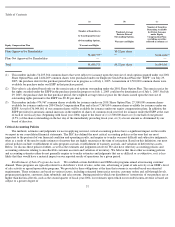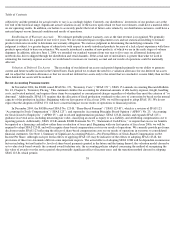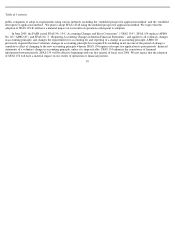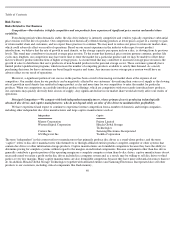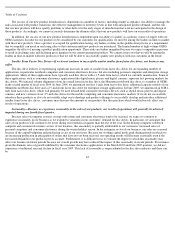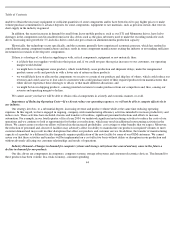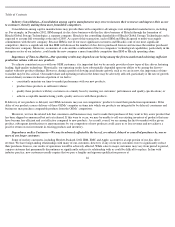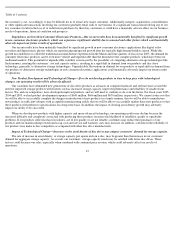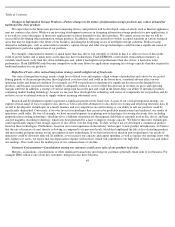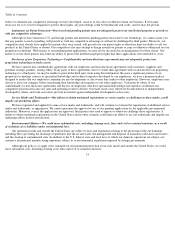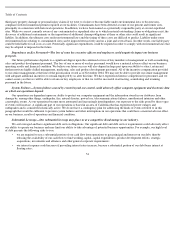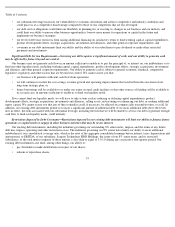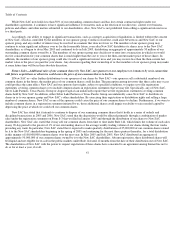Seagate 2004 Annual Report Download - page 50
Download and view the complete annual report
Please find page 50 of the 2004 Seagate annual report below. You can navigate through the pages in the report by either clicking on the pages listed below, or by using the keyword search tool below to find specific information within the annual report.
Table of Contents
the customer’s cost. Accordingly, it may be difficult for us to attract new major customers. Additionally, mergers, acquisitions, consolidations
or other significant transactions involving our customers generally entail risks to our business. If a significant transaction involving any of our
key customers results in the loss of or reduction in purchases by these key customers, it could have a materially adverse effect on our business,
results of operations, financial condition and prospects.
Dependence on Growth in Consumer Electronics Products—Our recent results have been materially benefited by significant growth
in new consumer electronics products, which can experience significant volatility due to seasonal and other factors which could materially
adversely impact our future results of operations.
Our recent results have been materially benefited by significant growth in new consumer electronics applications like digital video
recorders and digital music players which are experiencing unexpected growth after the typically high demand holiday season. While this
growth has enabled us to offset the traditional seasonal decline experienced in the March and June quarters of fiscal year 2005, the demand for
consumer electronics products can be even more volatile and unpredictable than the demand for the compute products, which have been our
traditional markets. This potential for unpredictable volatility is increased by the possibility of competing alternative storage technologies like
flash memory, meeting the customers’ cost and capacity metrics, resulting in a rapid shift in demand from our products and disc drive
technology, generally, to alternative storage technologies. Unpredictable fluctuations in demand for our products or rapid shifts in demand from
our products to alternative storage technologies in new consumer electronics applications could materially adversely impact our future results
of operations.
New Product Development and Technological Change—If we do not develop products in time to keep pace with technological
changes, our operating results will be adversely affected.
Our customers have demanded new generations of disc drive products as advances in computer hardware and software have created the
need for improved storage products with features such as increased storage capacity, improved performance and reliability of smaller form
factors. We, and our competitors, have developed improved products, and we will need to continue to do so in the future. For fiscal years 2005,
2004 and 2003, we had product development expenses of $645 million, $666 million and $670 million, respectively. We cannot assure you that
we will be able to successfully complete the design or introduction of new products in a timely manner, that we will be able to manufacture
new products in sufficient volumes with acceptable manufacturing yields, that we will be able to successfully market these new products or that
these products will perform to specifications on a long-term basis. In addition, the impact of slowing areal density growth may adversely
impact our ability to be successful.
When we develop new products with higher capacity and more advanced technology, our operating results may decline because the
increased difficulty and complexity associated with producing these products increases the likelihood of reliability, quality or operability
problems. If our products suffer increases in failures, are of low quality or are not reliable, customers may reduce their purchases of our
products and our manufacturing rework and scrap costs and service and warranty costs may increase. In addition, a decline in the reliability of
our products may make us less competitive as compared with other disc drive manufacturers.
Impact of Technological Change—Increases in the areal density of disc drives may outpace customers’ demand for storage capacity.
The rate of increase in areal density, or storage capacity per square inch on a disc, may be greater than the increase in our customers’
demand for aggregate storage capacity. As a result, our customers’ storage capacity needs may be satisfied with fewer disc drives. These
factors could decrease our sales, especially when combined with continued price erosion, which could adversely affect our results of
operations.
47


